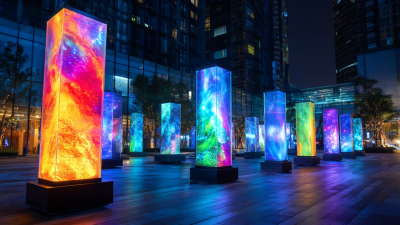



In today's competitive landscape, effective signage design plays a crucial role in shaping a business's image and driving customer engagement. According to a recent study by the Sign Research Foundation, 76% of people said they have entered a store they had never visited before based solely on its signage. This emphasizes the importance of design signage that not only attracts attention but also conveys the brand message clearly. Moreover, research indicates that a well-designed sign can increase sales by 7-10%, highlighting its potential as a valuable marketing tool. As businesses strive to differentiate themselves, incorporating innovative designs into their signage can enhance visibility and create a lasting impression on customers. This article explores five creative design strategies that can effectively transform your business image through impactful signage.

When it comes to creating eye-catching signage that can elevate a business's image, innovative material choices play a crucial role. Businesses are increasingly turning to unconventional materials that not only capture attention but also convey their brand message effectively. For instance, using eco-friendly materials can appeal to environmentally conscious consumers, while incorporating illuminated elements can enhance visibility at night, making signs stand out even in low-light conditions.
Furthermore, the design process should leverage the latest trends in typography and graphics to create a unique identity. Utilizing distinctive fonts can add character to the signage, while vibrant colors and textures can create a memorable visual experience. By experimenting with various substrates and incorporating current design innovations, businesses can craft signage that not only meets functional needs but also aligns with their brand ethos, thereby transforming their overall image and attracting more customers.
| Design Element | Material Used | Visual Impact | Durability | Cost Estimate |
|---|---|---|---|---|
| LED Backlit Signage | Acrylic and LED Lights | High | 5-10 years | $500 - $1500 |
| Vinyl Banners | Durable Vinyl | Medium | 1-3 years | $100 - $500 |
| Wooden Signs | Reclaimed Wood | High | 3-7 years | $250 - $800 |
| Holographic Displays | Holographic Film | Very High | 2-5 years | $1000 - $3000 |
| Digital Signage | LED Screens | Very High | 5-10 years | $2000 - $8000 |
Integrating technology into modern signage has become a pivotal move for businesses seeking to enhance their brand image and communication efficacy. Digital displays offer a dynamic platform that can be updated in real-time, allowing companies to respond swiftly to promotions, events, and customer engagement strategies. According to a report by the Digital Signage Federation, businesses that implement digital signage experience a 47.7% increase in sales on average. This statistic underscores how modern signage not only improves brand visibility but can significantly impact revenue.
When considering the installation of digital displays, it's essential to focus on content that captivates and engages. Eye-catching graphics and relevant information delivered in a clear layout can transform how visitors perceive your brand. **Tip:** Use vibrant colors and concise messaging to capture attention quickly—studies show that consumers respond more favorably to visually appealing and easily digestible content.
Furthermore, leveraging interactive technology within your signage can create an immersive experience that promotes customer interaction. Touchscreens, QR codes, and even augmented reality can deepen engagement, making it easier for customers to access information or promotions. **Tip:** Regularly update your digital signage content based on customer preferences and trends to maintain interest and drive foot traffic. By incorporating these tips, your business can utilize modern signage to not only enhance its image but also boost sales and customer loyalty.

In today's business landscape, the push for sustainability has permeated various industries, including signage design. With reports indicating that more than 75% of consumers prioritize brands that adopt eco-friendly practices, businesses are rethinking their signage solutions to align with these values. One popular trend is the use of recycled materials. According to the Sustainable Signage Standards, integrating at least 30% recycled content in signage can significantly reduce a company's carbon footprint, while also appealing to a growing demographic of environmentally conscious consumers.
Another notable trend is the incorporation of energy-efficient LED lighting in signage. A study by the U.S. Department of Energy found that switching to LED lighting can reduce energy consumption for signage by up to 75%. This not only lowers operating costs but also enhances visibility and aesthetics, creating a more engaging customer experience. Furthermore, businesses adopting solar-powered signage options are gaining traction; research shows that solar innovations can save nearly 25% on energy costs during peak usage hours, making them a financially savvy and eco-friendly choice. As sustainability becomes a core element of branding strategy, businesses that invest in innovative, eco-friendly signage are well-positioned to enhance their image and attract a loyal customer base.
Interactive signage has emerged as a powerful tool for engaging customers and enhancing business image. According to a report by ResearchAndMarkets, the global digital signage market is projected to reach $31.71 billion by 2026, driven by the increasing demand for interactive experiences. Businesses that integrate interactive designs into their signage can see a significant boost in customer engagement; studies indicate that consumers are 70% more likely to remember an interactive advertisement than a static one. This not only enhances brand recall but also increases foot traffic and sales conversions.
One effective approach to interactive signage is the use of touchscreen displays that allow customers to browse products, access information, or even participate in promotions. Incorporating augmented reality features further captivates audiences, transforming the shopping experience. Tips to succeed with interactive signage include ensuring that the interface is user-friendly and intuitive, as 83% of consumers prefer simplicity to complexity when interacting with technology.
Additionally, integrating social media interaction can elevate customer engagement. Encourage customers to share their experiences on social platforms directly through the signage. Data from Statista reveals that 54% of social media users engage with brands online, making this an excellent opportunity for businesses to leverage real-time customer interactions and enhance their image in the digital age.
Typography plays a crucial role in shaping a business's identity, particularly when it comes to signage. A well-crafted typeface can convey the essence of a brand and evoke specific emotions in customers. The recent launch of a bold custom typeface for a prominent animal welfare organization highlights the significance of typography in creating a distinctive image. This new font is designed to resonate with the public while effectively communicating the organization's mission, showcasing how thoughtful design can enhance recognition and connection with the audience.

Innovative signage designs take typography a step further by integrating it into compelling visual narratives. Businesses can leverage unique typefaces to establish a memorable presence in their communities. Whether it’s through bold lettering that commands attention or elegant scripts that convey sophistication, the right typography can transform an ordinary sign into a powerful branding tool. By prioritizing this aspect of design, companies can not only improve visibility but also foster a deeper emotional engagement with their clientele, ultimately elevating their overall image in the marketplace.






